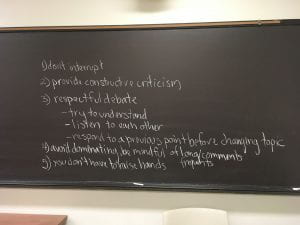 One of the most challenging aspects of remote teaching is keeping students engaged in the virtual classroom. Especially at a time when instructors and students alike are bombarded by current events and other responsibilities, without the chance to replenish their social batteries, it can be difficult to avoid distractions and to focus energy on a course. But UChicago instructors are creative and determined! The Humanities Division is delighted to spotlight its instructors’ approaches to these challenges, and celebrate their successes and innovations. This week, we sat down with Valerie Levan, Assistant Instructional Professor and Humanities Core Teaching Coordinator, to discuss her experience teaching a Core course remotely.
One of the most challenging aspects of remote teaching is keeping students engaged in the virtual classroom. Especially at a time when instructors and students alike are bombarded by current events and other responsibilities, without the chance to replenish their social batteries, it can be difficult to avoid distractions and to focus energy on a course. But UChicago instructors are creative and determined! The Humanities Division is delighted to spotlight its instructors’ approaches to these challenges, and celebrate their successes and innovations. This week, we sat down with Valerie Levan, Assistant Instructional Professor and Humanities Core Teaching Coordinator, to discuss her experience teaching a Core course remotely.
This past spring, Valerie found herself transitioning her Reading Cultures class to the virtual format. She already knew half of the 17 students from previous quarters, and understood from experience that students who remain enrolled in the optional third quarter of the HUM sequence often do so to work on writing. Armed with this knowledge and focus, Valerie initially made the decision to conduct the class completely asynchronously. The plan was to have discussions using Canvas exclusively, impressing upon the students that this was in place of regular class discussions and stressing the advantages of having time to prep for discussion in an asynchronous format. Valerie was pleased to see that the students responded well to this encouragement, engaging effectively with their peers through the written discussion posts.
Mixing Synchronous and Asynchronous Modes
After the second week of the quarter, however, it became evident that many more students had remained in Chicago than previously expected. Valerie reached out to the students for their opinion on synchronous class sessions, and they unanimously decided to shift formats. From then on, one class period a week was held synchronously on Zoom, and the remaining discussion was conducted asynchronously on Canvas. Valerie was concerned about creating spontaneity of discussion on Zoom, but after attending trainings with the Chicago Center for Teaching (CCT) and Academic Technology Solutions (ATS), she decided to structure the Zoom discussions by providing students with specific prompts and tasks. Although this wasn’t necessarily ideal for the spontaneous discussions that Valerie usually likes to encourage in face-to-face courses, she found it made Zoom discussions much more productive.
One-on-One
Initially, thinking that the class would be completely asynchronous, Valerie had scheduled weekly one-on-one meetings with each student. Although it took a lot of energy, she ultimately is glad that she followed through. It helped her understand where students were coming from going into the course, their reasons and goals for taking the class, and their concerns. Particularly for the students who Valerie didn’t already know, these were valuable conversations. As the course transitioned to partly synchronous, she continued to offer one-on-one meetings as a substitute to the Zoom discussions for students who couldn’t meet synchronously. She felt this worked very well, and gave students the benefit of the doubt in terms of their engagement. For Valerie, the participation grade simply represents the sharing of one’s ideas: the format can be flexible, as long as she knows each student is actively thinking about the content of the course.
Shorter Writing Assignments
Even synchronously, the focus of the class continued to be on writing, in order to best meet students’ goals for the quarter. For the virtual format, Valerie completely restructured the writing assignments. Usually, her Core courses involve three longer papers, but this spring she instead assigned five short assignments so that the students received more regular feedback. She also rewrote the assignment prompts to encourage creativity and engagement, asking students to write as if addressing a specific reader. For example, students used arguments and evidence from Marx’s Capital to write as if to their own governors, convincing them to support modern economic changes. Valerie was proud of how engaged the students were with these writing assignments, and intends to maintain that format in the future, even in face-to-face classes.
Collecting Student Feedback
In addition to restructuring discussions and writing assignments, Valerie made sure to account for the difficulty of online courses by incorporating student feedback and making edits to her usual grading scheme. Because she made so many adjustments to the course during the quarter, even though the students were involved in those decisions, she felt the need to communicate clearly with the students and make them feel like their input structured the course. She sent out surveys asking questions like “what is your ideal Zoom session length?” and confirming students’ availability. She was aware that for some students who had unstable internet connections or who were at home without a private workspace, attending synchronous classes at certain times might not be feasible. Valerie wanted to show that she was respectful of each student’s situation, and they responded well when she reached out for feedback.
Grading
As for the grading scheme, Valerie made a simple “COVID-19 Adjustment” in her gradebook, an automatic 15 points that each student was given. She did this because she knew the quarter would be stressful and didn’t want to penalize students as they adjusted to the new format for writing assignments. This way, she could still give substantive feedback by grading with her usual rigor, but the students wouldn’t feel as much pressure if they couldn’t adapt right away.
Takeaways: Respecting Context
Overall, Valerie was impressed with how engaged her students were with the course as a whole. Despite the stress of the pandemic and other current events, students submitted all their work, only ever asking for extensions. Nevertheless, Valerie remained aware of the difficulty her first-year students faced, and especially so this autumn quarter as she teaches Reading Cultures again. She knows that her students now are transitioning to college for the first time during a pandemic, juggling online classes, social distancing, and the election. “They’re in dorm rooms by themselves, they can only visit one friend at a time, and they eat in the dining hall 8 feet apart – it’s a very isolating existence,” she acknowledges. To help with this, she’s eager to build in more opportunities for what CCT calls “social presencing,” so students can get to know each other and socialize even in online class. This, as well as frequent opportunities for feedback and checking in, are important ways to keep students active, focused, and engaged.


